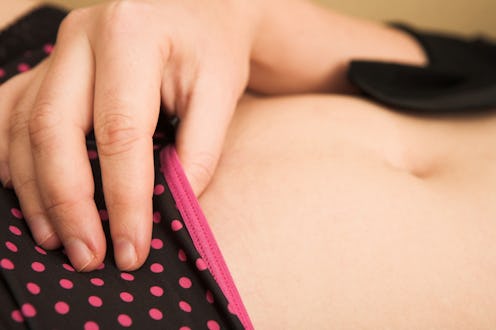
We know an awful lot about what goes on when dudes orgasm — but what women? BuzzFeed's new video, “How Do Women Orgasm?”, attempts to demystify the female orgasm — and not a moment too soon. In fact, most of us probably could have used this video way back when we were first learning about sex and our bodies. Too bad YouTube videos weren't a thing back then, right?
But hey, it's never too late to learn something new. BuzzFeed's Hillary Lauren Levine sat down with podcaster and educator Sex Nerd Sandra and video conferenced with sex therapist Vanessa Marin (who might be familiar to you from her columns on Bustle) to get down to the bottom of the issue — or rather, issues, plural. Pretty much any question you've ever had about how lady orgasms work? Hillary has had them, too, and now she's got the appropriate people to ask about them. Gaby Dunn, BuzzFeed's “unofficial resident sex guru,” also makes a few appearances.
So from the different types of orgasms to the deal with squirting, here are a few highlights; scroll down to watch the full video. You won't regret it. Everyone deserves to have awesome sex, and this is one way to make it happen.
1. What is a female orgasm, anyway?
According to Marin, it's experiencing “the apex of sexual pleasure.” Some line gets crossed, and when that line-crossing happens, what felt good becomes an explosion of awesome. That's the simple version, of course, but for most of us, it's the only explanation we need.
2. Is there more than one type of female orgasm?
Yep! Sandra breaks them down as follows:
- Clitoral orgasm: The type that happens from stimulating the clitoris and surrounding exterior area.
- Vaginal orgasm: The type that happens from stimulating the interior of the vagina. It's often referred to as a “g spot” orgasm, although the jury is still out about whether the g spot actually exists.
And there are even different types of vaginal orgasms, too. But as Marin points out, the type of orgasm doesn't ultimately matter; what matters is what feels good to you. Focus on that. As Sandra adds, “No orgasm is better or worse than any other orgasm.”
3. Does it matter how you get there?
Nope! Going with our "all orgasms are good orgasms” mantra, orgasms from P-in-V don't somehow “count” more than orgasms from other sources of stimulation. Besides, Marin states that only about 30 percent of women can orgasm from intercourse alone. If you're part of that 30 percent? Awesome! If you're part of the other 70 percent? Also awesome! Again, what matters is what feels good to you.
4. What's going on with squirting?
According to Hillary, every single person she spoke to about this video before she actually sat down to make it told her that she had to get to the bottom of what squirting is all about. Weirdly, a review conducted in 2013 of preexisting studies about squirting found that it could happen for 0.2 percent of the population… or 66 percent of the population… or pretty much anywhere in between. As the video points out, that fact is pretty much useless. So what's the deal?
Marin describes squirting as the “propulsion of fluid outside of a woman's body while she is orgasming.” Usually it happens at the same time as an orgasm; some women can do it separately, though. Sandra brought up the fact that recent research has made the claim that squirting in large volumes is actually coming from the bladder…. But she doesn't really care. In any event, squirting is generally thought to be triggered by stimulation of the g spot, which is inside the vagina toward the bellybutton — so if you spend some time with it, it might lead to squirting. Some people find the “come hither” motion lots of fun, but play around — find out what works best for you. Warning: Marin says you might feel the need to urinate, but I stand with Sandra: Who cares? If it's fun and it feels good, keep doing it.
5. What's the best way to get familiar with this whole orgasm thing?
One word: Masturbation. That's how you get to know your body: What works for it, what doesn't, what you like, what you don't like, and so on and so forth. It'll also help you learn to communicate what works for you to a partner. Never underestimate the benefits of a little self-love.
For more — much, much more — watch the full video below:
Images: Fotolia; Giphy (5)